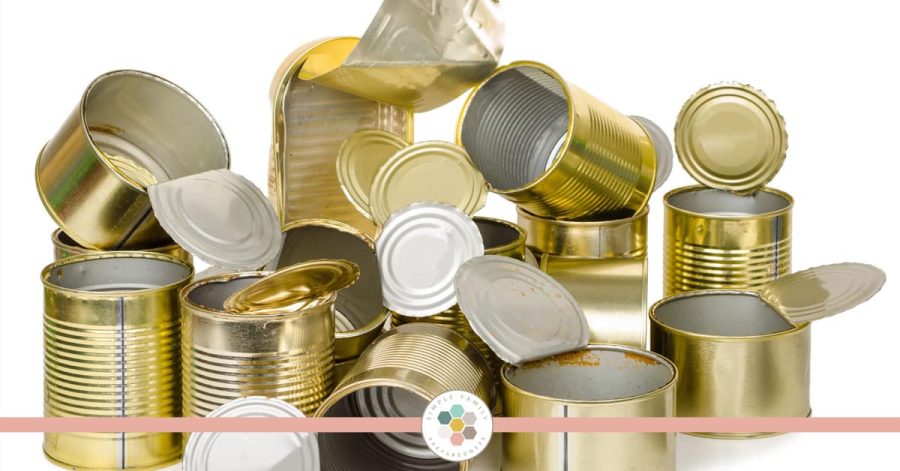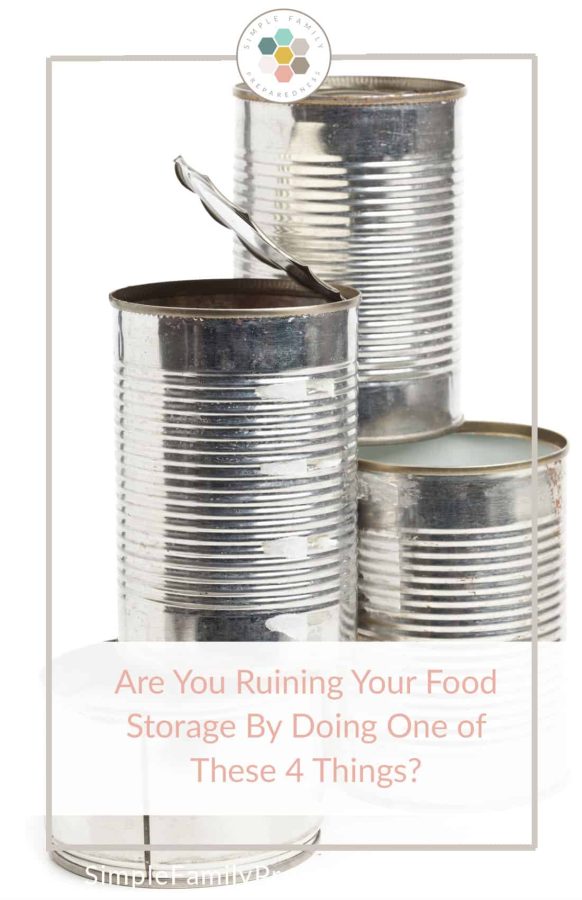Building a “home store” of food and other supplies isn’t easy: it requires a lot of time, effort, expense, and dedication. It takes work and, most important, knowledge of these 4 most common food storage mistakes. No one wants to waste that time, effort, expense, and work! Am I right?
Yet, more often than not, that is exactly what happens. Since 2010 or so, I’ve worked with many people that have had well-stocked food storage for a lot longer than I have and all of them tried to avoid these 4 common food storage mistakes.
So, you may wonder why these people have come to me as a food storage consultant if they already have a home stocked with food storage.
Well, the reason is that most of them have unwittingly “ruined” or wasted that food storage – and all the effort and money they put into building it – in one of the following four common ways.
4 Common Ways to Ruin Your Food Storage at Home
Please don’t invest in food storage if you don’t plan to keep it safe. Make sure you don’t ruin your food storage with one of these 4 most common food storage mistakes!
#1 Food Storage Mistake: Heat
Food should be stored between 40-70 degrees Fahrenheit: the cooler the better. Most of the “shelf life” ratings you will find on food are based on a storage temperature of about 60-70 degrees.
As a general rule, for every 10° over 70°, you cut your shelf life in half for most products. So, if you have a can of green beans from the grocery store that says it expires in three years, but you’ve stored them at 80°, you should probably throw them out after about a year and a half.
On the flip side, for every 15° under 60°, you double your shelf life for most products (to a point). So, if you store that same can of green beans at 50°, you would likely be safe using them four to five years later.
**The estimates above are rough estimates and will vary slightly depending on the study, but give you a general idea of how heat affects your food**
It is important to note that heat alone typically will not make your food unsafe to eat, but it will cause it to lose its nutrition and flavor, and that makes it unappealing and less useful as a nutrition source (though it will still have caloric value).
Some may say, well, it is 40 degrees in my garage in the winter and 90 in the summer, so that balances out to an average of about 60 degrees, so I’m good, right?
Unfortunately, that is wrong. Large temperature swings can be worse for your food than high temperatures. Big fluctuations in temperature like that can cause cans to expand and contract and mess with the seams, causing a poor seal (and exposure to oxygen & moisture…see below).
Many of the good-intentioned people I mentioned above stored their food in a hot garage and effectively “ruined” it–at least some of it. When they went to open it and use it, they found the food inedible even though it had a shelf life of 25 years and maybe it had only been 20.
Don’t make the same food storage mistake!
#2 Food Storage Mistake: Light
Exposure to both natural and artificial light can damage food. It is called photodegradation. Light causes a chemical reaction to food that can cause it to develop an off-flavor or a change in color or vitamin loss. Oil is especially susceptible to light as are vitamins A, D, and E.
As often as possible, food should be stored in opaque containers and kept in dark closets/areas of your home that are rarely exposed to light.
I’ve met many good-intentioned people who spent hours and hours over years of their lives canning food to preserve for later and then putting those beautiful glass jarred goods in an open pantry with lots of light exposure. When they went to eat the food they had spent so much effort on, they were sorely disappointed to find that all that light exposure had “ruined” their food stores.
Again, exposure to light does not automatically make your food unsafe to eat, but it will cause it to lose its nutrition and flavor which makes it unappealing and less useful as a nutrition source (though it will still have caloric value). This is especially true of fruits and veggies.
However, anything with oil or fat in it will go rancid quite quickly when exposed to light–canned meat, cooking oil, mayo, shortening, etc.
Don’t make the same food storage mistake!
#3 Food Storage Mistake: Humidity & Oxygen
Have you ever wondered why freeze-dried food has a longer shelf life than dehydrated food?
The reason is that it has a lot less moisture left in it. Humidity and oxygen speed microbiological growth and can make your food unsafe to eat.
Ideally, you should store your food at 10% humidity or below. However, this is very unreasonable for most areas. The solution to this is proper packaging.
Buy things that are already correctly packaged and sealed in food-grade buckets or mylar bags with oxygen absorbers for food.
You can also learn to properly package foods this way yourself.
In addition, even when food is properly packaged in a metal can, humidity can cause those cans to rust. If you live in a humid area and/or do not plan to regularly rotate and use your food, this is especially a risk. Ask food storage companies if they line their cans with food-grade enamel on both the inside and outside to prevent this from happening. I know for sure that Thrive Life does. I know that Emergency Essentials and the LDS Home Storage Centerline theirs on the inside only (which is better than no lining).
I’ve seen many well-intentioned people spend money on big bags of flour, rice, or anything else from Costco and throw it on a shelf in their cool, dark, but humid pantry–it was not properly packaged against oxygen and moisture.
Sadly when they went to use it, they found it rancid.
Don’t make the same food storage mistake!
#4 Food Storage Mistake: Time
Are you using your food storage? If not, you need to! Yes, 10-30 years is a very long shelf life, but it is still limited. And unless you are doing very well at all the above-mentioned things, the shelf life of many of your foods will likely be shorter. If you don’t use your food before that shelf life, you will waste it, and the most expensive food we buy is the food we throw away!
The solution is to only store foods that you enjoy eating and can incorporate into your everyday lifestyle. This makes rotation easy. I highly encourage you to try any food you are considering purchasing before you buy a large supply of it. Make sure you like how it tastes, that you can cook with it, and that the quality is high enough for your family.
Don’t make the same food storage mistake!
Avoid these 4 Food Storage Mistakes!
Finally, personally, I buy all my basics at the LDS Home Storage Center because they have the best prices around. Also, I buy all my freeze-dried meats, fruits, and veggies from Thrive Life. It is the highest quality food I’ve found. As such, it not only works as “food storage,” but as part of our everyday meals as well. Best of all, I won’t have to throw away thousands of dollars in food in 20-30 years because I never got around to using it.
Sadly, I’ve seen many well-intentioned people do just that. They invested thousands in food to protect their family, only to throw that food away years later because they didn’t use it and “ruined” it with time. That was some expensive food!
Pin This Post Now To Save It For Later And Share it With Friends!
Becky is a wildlife enthusiast and pet and livestock care expert with a diploma in canine nutrition. With over a decade of experience in animal welfare, Becky lends her expertise to Simple Family Preparedness through insightful info about pets, livestock, bee keeping, and the practicalities of homesteading.





We have a crawl space under my house that has been encapsulated & has a dehumidifier . We live in Va. Beach, Va .. Can I store my 25 years cans under my house ?
Hello from NY. I have 2008 stock in # 10 cans. Fall to winter stored in cold attic. Transferred to basement during warmer months with dehumidifier and temperatures fluctuating low 70’s to about highest 82 during spring, summer warmer months. States 20-25 year shelf life. Time to ditch them and reload? It has been 13 years now.
We have 5 gallon plastic containers with wheat, sugar, rice and beans that have been in inconsistent temperatures carting from 35 to 100 degrees that are in an old travel trailer. I am assuming that they are no longer good as we have had them for over 25 yrs. My husband thinks they are still good. Are they??
In relation to food storage: the upper foot or two of your house is usually a few degrees to 10 degrees warmer than near the floor. I don’t have a basement and use a spare bedroom for storage. i keep it dark and cool with the shades always drawn. i circulate the air pretty much every day by opening the door and turning on the ceiling fan a few minutes. I do not store way up top couple feet of my house because of the temps will shorten the life of my products. I also know wheat can be stored and usable even 50 years past the canning date. It may not taste the freshest, but it will keep you alive. Best to rotate your wheat and buy in good years when ample rain comes. You can keep an eye on the US Wheat letter for wheat and how well/bad the harvest goes. This year was not good because of the drought. Hopefully next year we will get better rain and I will purchase a little extra for my storeroom. Thrive has also great products which I use everyday. Don’t wait until an ER to use your food storage. Start learning to use it now.
Can you explain the numbers on the bottom of a LDS #10 can?
I”m honestly not sure Dan. But I will reach out to them and see if I can find out! Great question!
i have converted a closet in the den for my long term food storage. i live in very humid northwest Louisiana. We cut out a square in the door of the closet about 4″ from the top and glued a decorative vent over it so the a/c gets in there. it is very humid here. Do you think that is satisfactory? we keep the temp at about 73 F and lowest in winter at night about 60F.
ps, i love all your help.
M. Reid
Yes, that sounds perfect!
While I have invested in food stores through several venues (Wise, LDS, Thrive, Auguson Farms, and a few others), homes in Texas have no basements! Solid bedrock 🙁
The only options I have found are converting a bedroom to storage and using a temp controlled storage unit. I don’t have quite enough stores yet to justify a storage unit. But, I am getting to capacity in the bedroom…and closets…and under the beds…and on top of the kitchen cabinets…
😀
No basements is HARD Kitty! I was the same in California. Honestly, I didn’t worry about finding perfect conditions – I just rotated more often!
What is the cost comparison on a regular use basis of home preserved food vs freeze dried? The freeze dried seems very expensive and my budget does not allow for that. If it would be cheaper or at least equal to buy say freeze dried chicken vs chicken from the grocer I would be willing to try it.
I’ve never done that specific comparison Melissa. I know it is healthier b/c there is no heat applied like in home preserving. As far as comparing it to food from the grocery store, I’ve most vegetables to be about the same. Sometimes the freeze dried is even less when you factor in the waste with fresh from the store (like throwing away half a thing of celery you didn’t use). There is no waste with freeze dried. The meats and cheese are definitely more expensive than the grocery store. I don’t use them as often as I do the veggies, but I LOVE having them for nights when I forget to thaw out meat and just for the security of knowing I have them stored. The fruits vary widely. Some are about the same, others are more expensive, but I love how much healthier they are. Here is a link that talks more about the health of the freeze dried produce. (https://simplefamilypreparedness.com/5-reasons-to-use-freeze-dried-produc/)
Thank you for your wonderful web site. We are just beginning on this new adventure and I am trying to get all the information so I start correctly. I am so grateful for the Lord and His blessings.
Thank you again,
Alan and Betty Ludlow
You are welcome Alan and Betty! I’m glad to have you join us and encourage you to continue to comment / contribute. Much of the value of this site comes from the insights of my fabulous readers! (-:
Misty, this is such a great post! Thank you for showing how we can make our food storage last longer. Living in St. George, UT, it is very hard to keep my food cool without a basement, but I do keep it on the main floor, and it stays as cool as I can keep it! Thanks again for all of the info!
No basements here either Emma! Isn’t it tough!? You have to get creative!
Great article Misty. I’ve been storing food for many years and I am ashamed to admit that last fall I discovered two cases of food I ‘killed’ by improper rotation.
We’ve all done it Brigette! (-:
Great tips. I am in the process of making an inventory of the storage pantry, I have had to toss, or eat less than optimal food because of not using oldest first. One great tip I learned, if you store grains in 5gal buckets, and you don’t have oxygen absorbers, or mylar bags, or just need to have one bucket in use, add bay leaves to the container and it will help keep the bugs at bay. I won’t guarantee it (grin) but i haven’t found any bugs in the 3 years I have been using them.
I just found your site from Pinterest, and I can’t get enough. We have been “prepping” for a few years, but I still learn something new from great sites like yours.
Thanks for the great tip Christina! I did not know that!